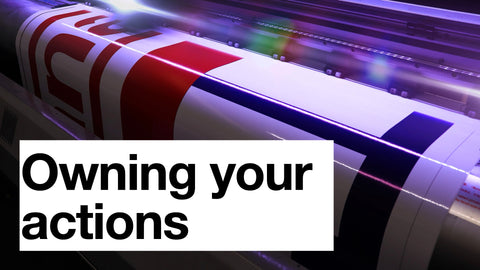These three cards will get you started. I’ll explain how to use them, then create an example at the end of the post.
First card – Movie Time.
Write at the top of your page: “The point I’d like to make is …”
Then write “For example…”
And pick a single case study or moment that illustrates your point.

Movie Time helps you describe your “For example…” story in more detail. These details start a little movie running in your audience’s heads: they can literally “see” what you mean.
Give them ACTION! (a real person, doing something in a real situation). Add some emotion: what’s at stake? Now they can see your movie, they’re ready to hear the point of your story.
- Pro Tip: if you can’t find a real “For example…” case study, create a plausible scenario instead. This story starts: “Just imagine…” but it follows the same Movie Time rules.
Second card – Show and Tell.

Your audience reads faster than you can. If you put 100 words on a screen, they start reading and stop listening to you. Your voice is now an annoying distraction. This is Death by PowerPoint!

Use Show and Tell to get your “For example…” story working right. Put one image and minimal text (five or six words) on a slide. Tell the audience what they’re seeing, then tell them stuff they can’t see: emotions, ideas, context etc.
- Pro Tip: better to use no image at all than a visual cliche. Please, no leaders scaling mountaintops!
Third card – Icebreaker Stories.

Set the stage with Movie Time, then show us how the action unfolds. Icebreaker Stories gives you a simplest way to structure your “For example…” story:
- Before: this is how things used to be.
- During: this changed suddenly.
- After: this happened as a result.
Use Movie Time to make sure you’ve got one vivid detail for each stage of the story. Use Show and Tell to create one slide for Before, During and After.
- Pro Tip: What happens if you start your presentation with a question? This is a classic Story Hook that keeps your audience listening to the end.
A sample presentation using these three tactics
Imagine you work for a printing company that’s just been taken over. You need to talk to staff about the new company values, in particular “owning your actions”.
I’ve created five simple slides and a script.

“What does “owning your actions” really mean and why is it one of our most important company values?
“Owning your actions” means we all have some degree of responsibility for what goes out of the door. Quality control is everybody’s job.
For example, take a look at this kids’ book.

What’s wrong with this image? And whose job is it to spot the mistake? Under the old system, we had a “not my job” culture. We could blame the printers who ran the press. They could blame the designer. And he could blame the client who approved the proofs. Mistakes like this were costing us clients. Worse still, the blame game was nasty, and meant we didn’t learn from our mistakes.

This is why you’ll see posters like this around the place since the takeover. Anyone can stop the press. We mean it. Stopping the press costs time and money. But if you see something that doesn’t look right, it’s your job to call a halt. I don’t care if you’re an accountant, a cleaner or a warehouse operator, quality control is never “not my job”.

Just imagine, next week Marko’s walking through the print floor. We’re midway through a menu run for a fast food chain. Marko thinks: “I know that brand, I’m sure the logo is brighter red.” It’s not his client, he’s not a designer. But he calls a halt so the logo can be checked. Maybe we pulp five thousand menus. But imagine how we’d feel, sending bad work to a client. Then it’s our job as a team to make sure that mistake doesn’t happen again.

This is what “owning your actions” means. It’s not a slogan, it’s Marko stopping the press. “Owning your actions” is the way we do things round here.”


If you leave us your email, we'll let you know if we update this guide based on your feedback.